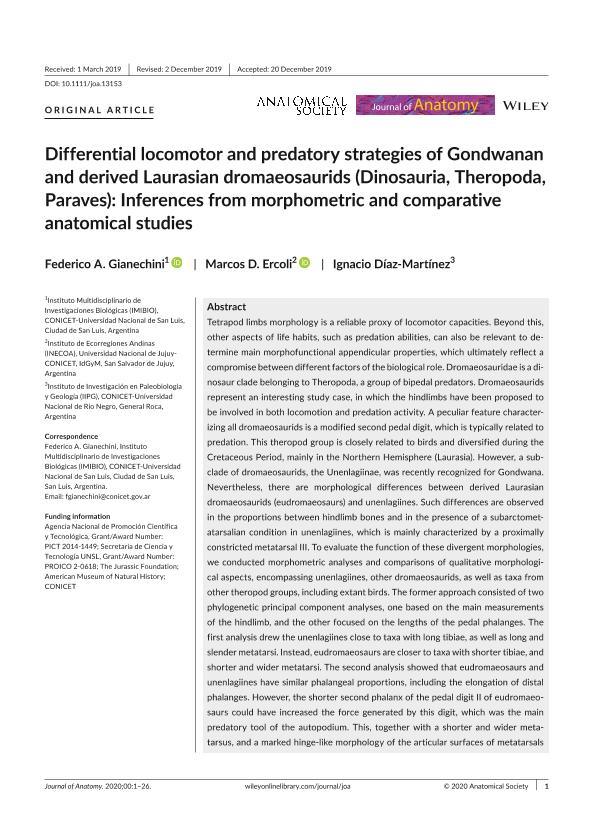Mostrar el registro sencillo del ítem
dc.contributor.author
Gianechini, Federico Abel

dc.contributor.author
Ercoli, Marcos Darío

dc.contributor.author
Díaz Martínez, Ignacio

dc.date.available
2021-10-26T10:48:30Z
dc.date.issued
2020-02
dc.identifier.citation
Gianechini, Federico Abel; Ercoli, Marcos Darío; Díaz Martínez, Ignacio; Differential locomotor and predatory strategies of Gondwanan and derived Laurasian dromaeosaurids (Dinosauria, Theropoda, Paraves): Inferences from morphometric and comparative anatomical studies; Wiley Blackwell Publishing, Inc; Journal of Anatomy; 236; 5; 2-2020; 772-797
dc.identifier.issn
0021-8782
dc.identifier.uri
http://hdl.handle.net/11336/145007
dc.description.abstract
Tetrapod limbs morphology is a reliable proxy of locomotor capacities. Beyond this, other aspects of life habits, such as predation abilities, can also be relevant to determine main morphofunctional appendicular properties, which ultimately reflect a compromise between different factors of the biological role. Dromaeosauridae is a dinosaur clade belonging to Theropoda, a group of bipedal predators. Dromaeosaurids represent an interesting study case, in which the hindlimbs have been proposed to be involved in both locomotion and predation activity. A peculiar feature characterizing all dromaeosaurids is a modified second pedal digit, which is typically related to predation. This theropod group is closely related to birds and diversified during the Cretaceous Period, mainly in the Northern Hemisphere (Laurasia). However, a subclade of dromaeosaurids, the Unenlagiinae, was recently recognized for Gondwana. Nevertheless, there are morphological differences between derived Laurasian dromaeosaurids (eudromaeosaurs) and unenlagiines. Such differences are observed in the proportions between hindlimb bones and in the presence of a subarctometatarsalian condition in unenlagiines, which is mainly characterized by a proximally constricted metatarsal III. To evaluate the function of these divergent morphologies, we conducted morphometric analyses and comparisons of qualitative morphological aspects, encompassing unenlagiines, other dromaeosaurids, as well as taxa from other theropod groups, including extant birds. The former approach consisted of two phylogenetic principal component analyses, one based on the main measurements of the hindlimb, and the other focused on the lengths of the pedal phalanges. The first analysis drew the unenlagiines close to taxa with long tibiae, as well as long and slender metatarsi. Instead, eudromaeosaurs are closer to taxa with shorter tibiae, and shorter and wider metatarsi. The second analysis showed that eudromaeosaurs and unenlagiines have similar phalangeal proportions, including the elongation of distal phalanges. However, the shorter second phalanx of the pedal digit II of eudromaeosaurs could have increased the force generated by this digit, which was the main predatory tool of the autopodium. This, together with a shorter and wider metatarsus, and a marked hinge-like morphology of the articular surfaces of metatarsals and phalanges, possibly allowed eudromaeosaurs to exert a great gripping strength and hunt large prey. Conversely, the longer and slender subarctometatarsus, and less well-marked hinge joints of unenlagiines possibly gave them greater cursorial capacities. Additionally, the longer second phalanx of digit II allowed unenlagiines fast movements of this digit to hunt smaller and elusive prey. Thus, the distinctive morphological evolutionary pathways of these two dromaeosaurid clades seem to have been influenced by the particular locomotor and predatory specializations that characterized each of these lineages.
dc.format
application/pdf
dc.language.iso
eng
dc.publisher
Wiley Blackwell Publishing, Inc

dc.rights
info:eu-repo/semantics/openAccess
dc.rights.uri
https://creativecommons.org/licenses/by-nc-sa/2.5/ar/
dc.subject
DROMAEOSAURIDAE
dc.subject
FUNCTIONAL MORPHOLOGY
dc.subject
LIFE HABIT
dc.subject
PARAVES
dc.subject
UNENLAGIINAE
dc.subject.classification
Paleontología

dc.subject.classification
Ciencias de la Tierra y relacionadas con el Medio Ambiente

dc.subject.classification
CIENCIAS NATURALES Y EXACTAS

dc.title
Differential locomotor and predatory strategies of Gondwanan and derived Laurasian dromaeosaurids (Dinosauria, Theropoda, Paraves): Inferences from morphometric and comparative anatomical studies
dc.type
info:eu-repo/semantics/article
dc.type
info:ar-repo/semantics/artículo
dc.type
info:eu-repo/semantics/publishedVersion
dc.date.updated
2021-09-06T20:38:01Z
dc.journal.volume
236
dc.journal.number
5
dc.journal.pagination
772-797
dc.journal.pais
Reino Unido

dc.journal.ciudad
Londres
dc.description.fil
Fil: Gianechini, Federico Abel. Consejo Nacional de Investigaciones Científicas y Técnicas. Centro Científico Tecnológico Conicet - San Luis. Instituto Multidisciplinario de Investigaciones Biológicas de San Luis. Universidad Nacional de San Luis. Facultad de Ciencias Físico Matemáticas y Naturales. Instituto Multidisciplinario de Investigaciones Biológicas de San Luis; Argentina
dc.description.fil
Fil: Ercoli, Marcos Darío. Universidad Nacional de Jujuy. Instituto de Ecorregiones Andinas. Consejo Nacional de Investigaciones Científicas y Técnicas. Centro Científico Tecnológico Conicet - Salta. Instituto de Ecorregiones Andinas; Argentina
dc.description.fil
Fil: Díaz Martínez, Ignacio. Consejo Nacional de Investigaciones Científicas y Técnicas. Centro Científico Tecnológico Conicet - Patagonia Norte. Instituto de Investigación en Paleobiología y Geología; Argentina
dc.journal.title
Journal of Anatomy

dc.relation.alternativeid
info:eu-repo/semantics/altIdentifier/url/https://onlinelibrary.wiley.com/doi/abs/10.1111/joa.13153
dc.relation.alternativeid
info:eu-repo/semantics/altIdentifier/doi/http://dx.doi.org/10.1111/joa.13153
Archivos asociados
